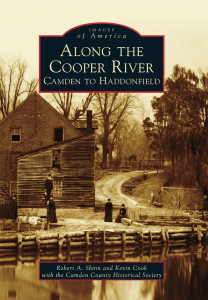New Book On Cooper River Overflows With History
 By Robert Fisher-Hughes, AAP Columnist and Amateur Historian
By Robert Fisher-Hughes, AAP Columnist and Amateur Historian
A flowing river with its tributaries, turns, widenings, narrowings, its pools and its occasional shallows and rapids, is a frequent and apt metaphor for history. A new volume in the popular “Images of America” series of local historical books, “Along the Cooper River: Camden to Haddonfield,” carries us on the currents of our local past, from the Lenni Lenape, to events as recent as last year. It is a voyage worth taking with authors Robert A. Shinn and Kevin Cook.
 Deer Creek became Cooper Creek when the Cooper family, English Quakers, took up residence on land near its outlet on the Delaware River near Petty’s Island. Cooper Creek in turn became Cooper River, this time by Act of Legislature in 1911. Less than two decades later, it had begun to be adorned with public parks and other well planned facilities of public enjoyment, aesthetically blended with a naturalistic landscape often reclaimed from commercial uses.
Deer Creek became Cooper Creek when the Cooper family, English Quakers, took up residence on land near its outlet on the Delaware River near Petty’s Island. Cooper Creek in turn became Cooper River, this time by Act of Legislature in 1911. Less than two decades later, it had begun to be adorned with public parks and other well planned facilities of public enjoyment, aesthetically blended with a naturalistic landscape often reclaimed from commercial uses.
The historic and economic developments that transformed Cooper River from a water way used for transportation to industrial and then recreational uses in the course of more than 250 years are illustrated in almost 200 historic images that will bring out magnifying glasses all over South Jersey for years to come. Like some optical illusion, it may take only a moment’s close attention to transform the long vanished landscape in any of these photographs into the familiar surroundings of today.
Along with the images themselves, the well-researched and informative chapter introductions and captions tell a story that may awaken new associations to common places. For example, did you know that the high ground on the Camden side of the river near Admiral Wilson Blvd. might have been the scene of a surprise attack on Dutch colonizers if they had not been secretly warned to escape? Or have you heard the story of the world’s shortest air mail route served by a strange hybrid aircraft called the autogyro flying from Central Airport in Pennsauken?
Other photographs depict the development of the parks along Cooper River in Camden and the development of local roads and bridges to serve the new Delaware River Bridge as a new age of transportation came into its own. There are glimpses of the old, such as the Hatch farm buildings before giving way to new roads and development, and the new, such as nearby Central Airport and the Hollingshead drive-in theatre.
The book draws heavily on the most accessible repositories of images locally, held by the Camden County Historical Society and Haddonfield Historical Society, as well as private collections such as the invaluable resources of information and materials held by local historians such as Paul Schopp, Cliff Brunker, Dennis Raible, and many others. Many of these images are too little known to our communities, who will now have the chance to appreciate them in the context of the narrative of our region.
Appreciation of the significant story written into the very landscape may be the most important motivation of the authors of “Along Cooper River.” Kevin Cook was drawn into the field of history and preservation when he was inspired by the sad plight of a historic building near Wallworth Lake on Cooper River in Cherry Hill. Cook’s crusade to save the building named the Wallworth Park Clubhouse, the first structure built by the Camden County Parks Commission, unfortunately proved unsuccessful.
This experience has inspired a broader effort, led by Cook and Robert Shinn, along with the State of New Jersey Historic Preservation Office, to secure official recognition and preservation of the Cooper River parks as a historic district, an effort gathering public and professional support. Shinn and Cook are urging the New Jersey State Review Board for Historic Sites to consider the nomination to list Cooper River Park as an historic district on the New Jersey and National Registers of Historic Places this summer at their Review Board meeting on July 17.
Robert A. Shinn is the treasurer of the Camden County Historical Society and has been involved in the effort to research and interpret the history of Pennsauken’s Petty’s Island, in conjunction with New Jersey Audubon. Shinn presented a slideshow about the history of Petty’s Island and the plans for its preservation and interpretation at Griffith Morgan House in 2013.
The book “Along the Cooper River” is also the subject of a new community page on Facebook. By going to http://www.facebook.com/AlongTheCooperRiver, visitors can find examples of photographs featured in the book and additional images, as well as stimulating conversation among users who share their questions, comments and personal recollections of the scenes.
“Along the Cooper River: Camden to Haddonfield” is on the shelves at Camden County Historical Society, and available to purchase at Barnes & Noble or for online order at ArcadiaPublishing.com or Amazon.com for a $21.99 retail price. Also, watch for upcoming opportunities locally to hear authors Robert Shinn and Kevin Cook discuss their book, the history of Cooper River and their work for historic preservation on our local landscape. The first upcoming opportunity will be the afternoon of March 22 from 1 to 3 p.m. at Camden County Historical Society’s headquarters near Lady of Lourdes Hospital, for a short talk about the book and a chance to see some of its and other images along the Cooper River, to share your own family’s relationship with the river and park, and to get a tour of the historic Joseph Cooper Pomona Hall building that is part of the Camden County Historical Society’s complex. The event is free and open to the public, and light refreshments will be served. You may come away with a fascinating book, autographed, and perhaps a new cause.
Sources for this column include “Along the Cooper River: Camden to Haddonfield,” Robert A. Shinn and Kevin Cook with the Camden County Historical Society, Arcadia Publishing, 2014; and documents related to the nomination of the Cooper River Park Historic District to the State of NJ and Federal Registers of Historic Places.

